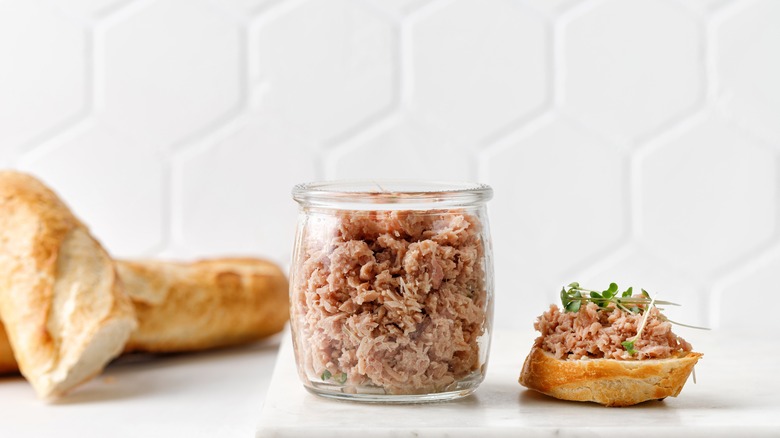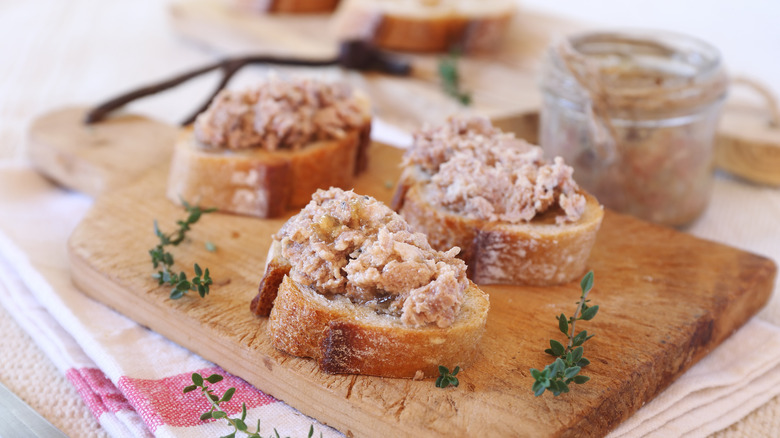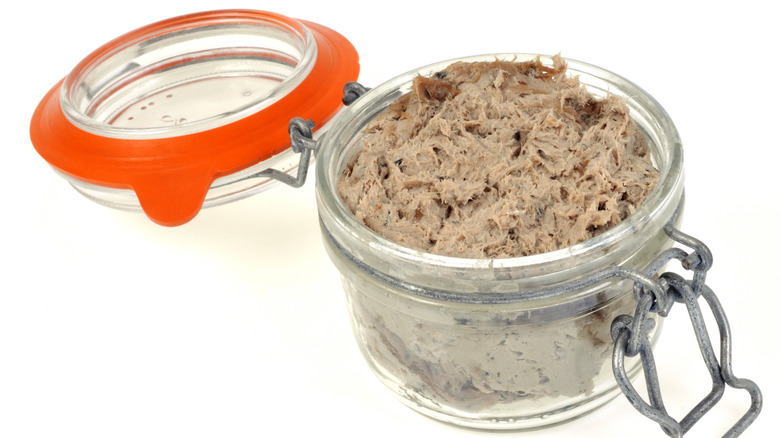Rillette Is The Fanciest Way To Enjoy Leftover Meat Bits
Groceries are more expensive than ever lately. Inflation may be cooling down a little, but we're probably stuck with a lot of high prices on foods including beef, eggs, and chicken (per CNBC) for at least several more months.
There are ways to fight back against expensive grocery bills, however. Savvy shoppers are increasingly switching to generic or private label food brands, shopping in bulk at warehouse stores such as Costco and Sam's Club, and price checking and using digital coupons. But all that saving doesn't matter if you end up tossing anything edible in the trash, either because it's past its expiration date or you used parts of something and threw the rest away as scraps.
Food waste is a huge issue around the world; the FDA estimates that Americans waste between 30% and 40% of the food supply. On a national scale that loss amounts to around $161 billion, but do the math and calculate 30% of your monthly food bill. U.S. News and World Report estimates that for a low-cost budget, a family of four spends an estimated $234.10 a week, or between $936.40 and $1,014 a month — 30% of that can be as much as $300 going in the trash each month. That's like a whole week of groceries. Fortunately, there are creative (and delicious) ways to use your leftovers.
Use up all of your ingredients
Saving money on food doesn't mean sacrificing quality. In fact, some of the world's fanciest restaurants serve dishes that were created to use every part of an animal. At home, this is just being thrifty, but at a four-star restaurant, this practice is called "nose-to-tail" cooking. Chefs live and die by food costs (per Toast), which can determine if a restaurant can even keep its doors open. So they're always looking for ways to use any edible food scraps.
One of the fancy ways chefs use meat and fish scraps is making rillettes. Rillettes are savory spreads made by slowly cooking pieces of meat in well-seasoned fat until they're tender and spreadable (per Food & Wine). They are then stored in a container with a layer of fat on top to preserve them. You may have seen rillettes on menus at your favorite brassiere or wine bar; they're great as appetizers, on a charcuterie board, or spread on toast for an umami-rich breakfast.
Rillettes are traditionally made with pork, but anything with a decent amount of natural fats, including duck, beef, tuna, and salmon, works great. It's a smart way to use up scraps from a large roast or for using up the bits from a whole duck or fish.
Make rillettes at home
If you want to make a rillette at home, the method is pretty simple and only requires a few ingredients. The key is cooking your meat and fat low and slow (per Food & Wine), around 200 degrees Fahrenheit. This method, which is called confit, slowly breaks down the proteins in the meat without drying it out.
It's most often used for making duck legs, but the method works well for any meat, fruit, veggies and herbs that you want to preserve (per MasterClass). For tougher cuts, such as beef and pork scraps, Food & Wine advises adding them to a pot of olive oil or heated fat and cooking slowly for a few hours until the meat is falling apart. When it's ready, tear it apart with two forks or your hands (after it's cool) and mix it up with the fat, or use a stand mixer on low with a paddle to mix everything together as a spread, then store it in a jar with a layer of fat on top.
You can speed up the process by stirring up your already-cooked, chopped meat scraps with seasoned fat and making a spread. This is great for fish, which is already pretty soft when it's cooked. Try mixing your salmon bits with softened butter and a little olive oil for quick salmon rillettes.


